
How to Pack for a Backpacking Trip – The Abc’s of Healthy, Happy Packing
In a previous post, I gave you a 3 day backpacking checklist. So you already know what to pack. But knowing how to pack for a backpacking trip is just as important. Believe it or not exactly how you stuff things into your pack can make or break your backpacking trips. The way you pack can impact your health, happiness, and safety.
So it’s important to know how to do it correctly. Yes, there are right and wrong ways to pack. In this post, we’ll talk about the right way to pack your backpack and throw in some nifty tricks you can try out as well.
Compartments and pockets
Different packs will have different compartments and pockets. Some will be highly compartmentalized with many specialized pockets, some will essentially be a big sack with straps. There will also be many packs that fit somewhere in between.
I won’t tell you which type is best. In fact, there is no such thing as some sort of ultimate pack that’s best for everyone, it all comes down to personal preference. If you’re a “place for everything and everything in its place” type of person, you might wish to get a pack with a lot of compartmentalization and special pockets. But you may be someone who just likes everything all together in one main chamber. Either way is fine.
I personally like to have a few separate pockets to help keep everything organized. Some extra pockets that I like are mesh water bottle pockets, hip belt pockets to keep snacks in, and some type of easy access pocket for gear that I might need quickly. Zippered side pockets or the brain (the pocket inside of the “lid” of your pack) are both good for easy access.
You may also want a compartment for a hydration pack. Be careful about too many extra pockets though, as you may find that some are just plain not useful, like this random little pocket underneath the brain that I lost my favorite socks in until I found them just now! But again, this is personal preference and who knows, it may be useful to you.
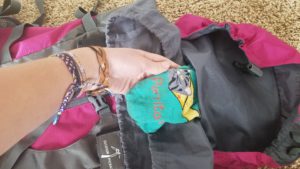
Other things you should be aware of are extra straps on the outside of your pack. You will likely use some of these to attach your sleeping pad or perhaps some other items.
The ABC’s of packing
Regardless of the pack you choose, it’s going to have a large main chamber and this is obviously where the majority of your gear is going to go. But hold your horses, you can’t just go dumping everything into your pack willy-nilly! This requires some strategy.
The main components of this strategy can be easily remembered as the ABC’s of packing.
1. Accessibility
There are things you will need throughout your hike and there are things you won’t need until you make camp. Take this into account when you are packing your pack.
For example, if it starts to rain and you have to pull everything out of your pack just to get to your rain jacket, well, to be blunt, life is going to suck. At this point not only are you wet, but your pack and everything you’ve had to pull out of it are wet as well!
Don’t let this happen to you! When packing, many people like to lay everything out on the ground. Then you can choose which items you will definitely need during the day, which items you might need, and which items you will definitely not need until camp.
Store items like food, sunscreen, map, etc in easy access pockets. Store things you may need (but it’s not a sure thing) somewhere near the top of the pack so they’re still relatively easy to grab if you end up needing them. Items like your sleeping bag can be shoved down into the depths of the pack.
A good backpacking pack usually will also have a zipper that allows you to access the main chamber from the bottom as well as the top. This can make things at the bottom of the pack accessible to some degree as well.
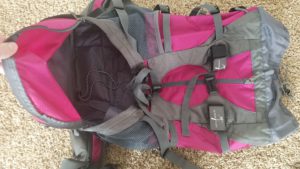
While you’re thinking about where to put things in your pack, keep in mind that things like fuel and food should never be stored in the same location. Make sure to keep your fuel separated from your food! A good rule is to always store fuel below your food in case it leaks, that way gravity will pull the leaked fuel down and it won’t touch your food.
2. Balance
Balance is extremely important! Improper balance can make your pack feel way heavier than it actually is. And the lighter your pack feels, the better you feel, and the more awesome your adventure. Not to mention improper balance can result in discomfort and injury.
There are 3 principles for correct balance.
1. The heaviest objects in your pack should be closest to your back. Think about giving a child a piggy-back ride, if they suddenly lean back and away from you are they easier or more difficult to carry? Definitely more difficult! It’s the same with your pack. If heavier items are placed toward the outside, then you pack will be constantly pulling you backward.
2. Top to bottom balance. You don’t want to be top or bottom heavy. Distribute the weight so that the heaviest items are just below your shoulder blades.
3. Balance from side to side. If all your heavy items are on the right side, you will feel lopsided and this could create real physical problems for your back.
The trick is to make your pack weight feel like an extension of yourself!
If you are travelling off-trail or on rough terrain, you may want to position the weight a bit lower on your back to help you feel more stable.
3. Compression
You want to use your pack space as efficiently as possible! Fill up all the air spaces! Put your food bag inside your cook pot, stuff your pajamas into an empty space.
You may want to use compression sacks to make large items smaller. My sleeping bag would fill half my pack if I just tossed it in there,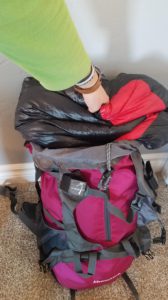 but when I compress it, it’s size is reduced drastically!
but when I compress it, it’s size is reduced drastically!
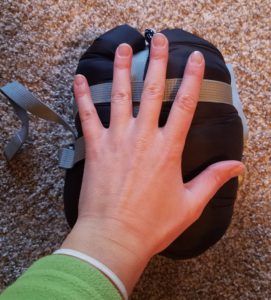
Don’t go crazy with the compression sacks though. Some items, like clothing, are better suited for stuffing into extra spaces between the big items. Think of it like bricks and mortar. The big items are the bricks and the smaller items are the mortar.
Throughout this whole process, do not forget the accessibility requirements for each object! You don’t want to get so caught up in stuffing things in that you forget everything you decided in the letter A.
Don’t attach things to the outside
(I tried really hard to make this section heading fit into our alphabet sequence.)
There may be a temptation to attach a lot of things to the outside of your pack. Resist!
If there are bunches of items hanging off your pack it will be rattly, it will be jangly, and it will throw your balance as things are constantly shaking around. Stuff those things into your pack! If they don’t fit, perhaps you need to go back to the drawing board and pack less stuff. Or just compress it better.
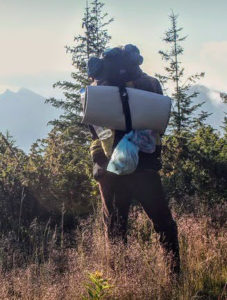
That being said, It is OK to keep some things on the outside namely a rolled up foam sleeping pad or perhaps an ice pick. If you need one.
Extra tidbits
Now that you’ve got the ABC’s down, be aware that everyone has their own packing style, and, aside from the general principles, you don’t have to copy someone else’s style exactly. Do what works best for you.
Here’s a list of things you may want to try for yourself:
- Before you pack, line the inside of your backpack with a plastic trash bag, pack everything inside of the trash bag to help it stay dry if you get caught in a rainstorm.
- Attach your foam sleeping pad to your pack in a vertical position instead of horizontal. This is more streamlined and the ends won’t stick out and catch on trees and bushes and things.
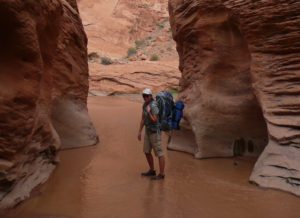
- Keep small items in a separate stuff sack so they don’t get lost in the depths of your pack.
- Instead of compressing your sleeping bag, you may want to just stuff it into the bottom of your pack, this way it’s an easier shape to pack other things around. (This doesn’t work well with a small pack or a bulky sleeping bag)
- Pack the tent, rainfly, ground cloth, poles, etc. separately, so that they are easier to shove into empty spaces.
Finally, keep it light
As a general rule, your filled backpacking pack should not weigh more than 20% of your body weight. A quick and easy way to weigh your pack is to weigh yourself on a standing scale, then weigh yourself carrying the pack, finally subtract the first weight from your combined weight.
If your pack weighs too much, it’s time to think hard about what you will really need during your trip. Do you have a big unnecessary multi-tool and could go with a less complex, lighter knife? Do you really need more than one t-shirt? Does your mess kit have too many unnecessary items, like mugs, extra lids or handles?
How about your food. Did you remove any unnecessary packaging? Are you bringing too much? This question, in particular, can be difficult to answer as a novice backpacker. To learn more about how much food you should be bringing be sure to check out this article.
Remember that 20% is a rough guideline and is highly influenced by things such as the length of your trip and your own body weight. If you don’t weigh much at all, it could be difficult to get your pack weight under 20%. If you weigh quite a bit, you may clear the 20% margin by a lot. So don’t go crazy trying to keep to some hard and fast percentage rule.
(You) Got this!
(Yes I know, this was a stretch but the next letter was a G so there you go. And if you couldn’t already tell, the ABC’s of packing is really only the first three letters anyway.)
As you continue packing your backpack, it will get easier. You will develop your own tips and tricks for packing your backpack. Eventually, you’ll have the process down and you won’t need to lay all your gear out on the floor if you don’t want to.
I hope you pack your pack often and go on lots of trips. And remember a well-packed pack makes for a pain-free, happier, adventurous you.
If you’re a packing master leave your own tips in the comments!
If you have any questions feel free to ask and I will do my best to answer them!
Happy Packing.
16 thoughts on “How to Pack for a Backpacking Trip – The Abc’s of Healthy, Happy Packing”
Never underestimate the power of compression when it comes to packing your backpack. Not to brag, but I am a master of Tetris when it comes to folding sleeping backs, compressing covers and cases, rolling up cords and strategically placing them into a limited space that is your backpack. My girlfriend is always amazed by how much I can fit into one bag. I’m glad you mentioned this in your article. I think it’s a valuable skill!
It is a valuable skill! If you’re a packing master you deserve to brag about it. 🙂
Absolutely great insights,
I am quite the backpacker myself and I find everything you are stating to be quite true. Having a special place for everything makes it much easier and more beneficial when the time comes to get said item.
I will have to take some notes on the not hangin things off of you pack, I have done this for years, but it does make sense. If you have to do that then you probably need a bigger pack.
For your “D” you could use “Detach”. Detach all items from the pack! Haha
Thanks again for the insights,
Nic
Hi Nic!
If hanging things off your pack has worked for you for years, I’m not going to tell you that you’re absolutely wrong. But I will say that there might be a better way, so you may want to give it a try! And thanks for the heading suggestion!
Your very well-written article reminded me how much I love pockets when packing. I’m a stickler for packing in the most organized way possible. It makes my travels much more enjoyable.
I like the acronym, the ABCs of packing. Now I’ll always remember accessibility, balance, and compression. Great tips for packing effectively and conveniently. Thank you!
I’m so glad you found some value in my article Holly! See you around.
I love your ABCs of packing and thank you so much for sharing. I enjoy travelling, but because I have a chronic back problem I really struggle with carrying a heavy backpack. I think my problem has been as a result of improper packing and not considering my weight, I also believe I go overboard and pack too many things that I could do without. This has been very helpful and I will share the tips with my son for his next camping trip.
I’m glad you found this useful Florence! I hope your son will enjoy the article as well.
Thank you for this article Mariah.
You have given us some excellent tips on packing a backpack.
I’ve never been into backpacking, but I use some of your tips for packing my luggage when I visit family and friends. However, I usually end up packing way more than I need. So, I’ve begun getting the basics in, then adding whatever else will fit. It’s nice to be able to handle the luggage without difficulty so I can enjoy the trip.
Thanks again,
Karen
Thanks Karen! I’m glad that some of these skills translated over to travel packing for you.
Thank you for a fascinating article. I have been thinking about a lot of hiking possibilities, and you could say that I’m starting to prepare already. I have been searching a lot about useful tips and advice and I found this post because of it.
And it was beneficial. For example, I must admit that I have not focused enough to have things balanced which is important like you said, especially for people who sometimes have back problems!
You said it is best to balance from side to side. I thought it was best to start with putting the most massive things in the middle and work from that position. With the idea to have things balanced in the middle. Is that the wrong idea? Have in mind that where I hike, there aren’t stores for a long time, so I need to get things like foods without too many problems. Brilliant idea to keep small items in a separate stuff sack, I will use it.
Thanks again for the helpful article, I will come back for sure!
You are right! You want it balanced in the middle of the pack. The point is to avoid having anything heavy on one side and not on the other.
Thanks for reading! I think you would enjoy this article as well, 3-day backpacking checklist, it will help you prepare and learn what items you should bring on your adventures.
Hi Mariah ,
Thanks for this article. You touched on points that are very useful and I do appreciate it so much. Indeed packing a Backpack properly for the journey is the best way of making the trip enjoyable. I really liked your first three components to follow. They were very helpful reading.
Especially the fact that you highlight the need to keep items that are frequently used at an accessible place in the backpack. It really makes sense since that will make it more easier to reach out for them whenever there are needed urgently.
Also, keeping balance of the weight of items we use is very necessary. This is true in a sense that, overloading a backpack for a trip will ONLY lead to fatigue in the shoulder muscles and will make the purpose of the trip, whether hiking you want went or whatever not be enjoyable. The idea of keep the weight close to your back also makes sense very well.
Thanks a lot for sharing this useful information with us.
Stephen.
Hi Steven! Thanks for reaching out! I’m glad you enjoyed the article. You may also like to check out this one as well.
Thank you for sharing with us your tips on packing for backpackinging trip.
I like to keep my thing organized and so my backpack has many compartments. I like the way you use ABC to remember the importance of packing correctly, Accessibility, Balance and Compression.
The other things that I need to be aware of is don’t attached things to the outside. Your tips are definitely helpful for us to pack our backpack.
I’m so glad I could be of help to you Christine! Thanks for reaching out. Since you enjoyed this article you should definitely check out this helpful article about what to pack for your backpacking trips